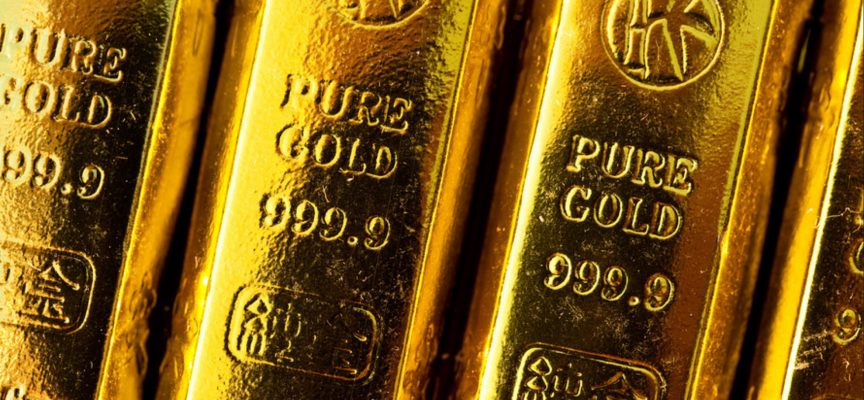Today one of the greats in the business said that the price of gold is now set to kickoff one of the greatest bull markets of all time.
Gold Set For One Of The Greatest Bull Markets Of All Time
November 5 (King World News) – Dr. Stephen Leeb: “The last 40 to 50 years have been outliers for gold. Gold has played a monetary role for several thousand years. But until the 1970s, its well-deserved reputation as a store of value was earned almost exclusively during periods of deflation, not inflation. I am comfortable in saying that while gold could have one more downdraft, it almost surely will be the last one. Buying now and buying with both hands on any weakness is buying a stake in what will be one of the greatest bull markets of all time…
ALERT:
Mining legend Ross Beaty (Chairman Pan American Silver) is investing in a company very few people know about. To find out which company CLICK HERE OR ON THE IMAGE BELOW.
 Sponsored
Sponsored
Dr. Stephen Leeb continues: “The book “The Golden Constant” by the late Roy Jastram, first published in 1977, is considered the bible of gold prices, especially those recorded in Britain and America. The book begins its look at gold prices in the late 15th century. Data from that far back isn’t continuous, but it still gives a good picture of moves in the yellow metal. Continuous data begins in 1560. A recent update in the book authored by Jill Leyland brings the record up through 2007.
In the original 1977 edition of the book, Jastram drew several conclusions that would no doubt strike many people today as surprising:
-
- “Gold is a poor hedge against major inflation.”
- “Gold appreciates in operational wealth in major deflation.”
- “Gold is an abysmal/ineffective hedge against yearly commodity increases.”
Those statements, so out of line with more recent realities, are a striking indication of how much gold’s role has changed over the past two generations.
The table I’ve created provides further details about gold’s performance over time by comparing gold’s performance with the U.S. stock market. It lists every period since the mid-19th century in which total returns from stocks were negative for at least three years. In every case since data was available, 1824, whenever stocks did poorly over such a relatively long-term stretch, returns from gold were positive. (The data for stocks comes from the SBBI Yearbook, published by Duff & Phelps and edited by Roger Ibbotson.)

One highlight of this study is that it is not the dollar that is relevant to gold bull markets, but the stock market. A bear market for stocks for nearly two centuries has been a bull market for gold.
What’s particularly relevant for investors today is that the three most recent periods of poor market performance/positive gold performance occurred during commodity bull markets, years in which commodity scarcities led to rising commodity prices and higher overall inflation. In all three periods, the first of which started in 1972, gold was the leading performer among assets considered commodities (gold should be viewed as both a commodity and a currency).
In other words, since 1972, gold has been behaving in a very different manner from all the years before. The change occurred in the context of gold prices that, starting in the early 1970s, were no longer fixed and with gold no longer playing a direct role in the global monetary system. (Jastram likely thought the gains in gold in the 1972-77 period were not durable when he made the conclusions we noted above.)
Gold Will Rise During Bear Market In Stocks
This is more than a history lesson. Rather, it offers a clear message to investors today: If there is a bear market in stocks in 2019 that leaves the three-year total return in equities in negative territory, gold is nearly sure to rise. So we need to look at how likely it is we might get such a bear market in stocks, one that could wipe out the gains we have seen since 2016 and will leading to the blistering bull market in gold that will underlie a new monetary system in the East and possibly the entire world.
It all revolves around China. When I think about China one phrase keeps popping into my mind, and it scares the daylight out of me. That simple phrase is “what goes around comes around.” The U.S. won the Cold War by outspending the Soviet Union on defense, with the Soviet Union running itself into the ground by trying to keep up. That led to a decade or more of dire consequences for most of the FSU, including Russia.
This time around it’s the U.S. vs. China, a much more formidable foe. And this time around, it’s the U.S. that appears to be in the far more vulnerable position.
A startling recent data point has been the poor performance of defense stocks despite blockbuster earnings. Whenever stocks sell off in the face of much better than expected earnings, it signals that investors have some general unease about the sector. In this case, I see it as a sign that investors believe we won’t be able to raise defense spending. Even Trump in a cabinet briefing on October 31st said defense expenditures will fall in 2020. The current allocation of $716 billion has become a ceiling not a floor.
In other words, when it comes to defense we have shot our bolt. We are spending as much as we can afford given all our other obligations, which now translate into trillion-dollar deficits.
A strong military defense is one of the critical ingredients for any country that has or wants to maintain its currency as a global reserve currency. And when it comes to defense, China has some major advantages over the U.S. First and most important, it isn’t looking to dominate throughout the world. Rather, the sphere where it wants to be dominant is the East and in most emerging economies. This more limited objective means it doesn’t risk bankrupting itself by seeking to be everywhere at once.
As I have pointed out before, a China which controls the China seas and has a strong stake in Central Asia is a China that has an unassailable position in Eurasia – tantamount to dominating the Eastern part of the globe.
China’s Control Of Commodities
And then there’s China’s control of critical commodities ranging from rare earths, which are vital in the most advanced defense products, to other critical metals such as cobalt and graphite.
In addition, China works closely with its leading AI companies, resulting in fertile public/private partnerships that will boost China’s technological capabilities – capabilities vital to both defense and domestic programs.
A recent comment by Mike Burgess, director of cyber operations in Australia, gives an indication of just how successful China’s tech push is. As quoted in Business Insider, Burgess said that banning Chinese tech companies like Huawei “was in Australia’s best interest and would protect the country’s critical infrastructure.” Critical infrastructure refers to everything from water to electricity to health. That wariness about allowing Huawei in suggests enormous respect for China’s tech prowess. You won’t see Apple phones banned in Australia or for that matter in China, either.
In pursuing technology through close relationships with private companies, China is borrowing a page from U.S. history. During World War II and for more than a generation after, the U.S. government worked closely with AT&T. This private-public monopoly ran what was probably the greatest research institute ever. Transistors, information theory, superconductivity, the Internet, and lasers are just some of what came out of it. Indeed, it was the willingness of the government to buy and use these products aggressively that led to the stupendous learning curves, with the miniaturization of transistors the most notable development.
Bell Labs, along with other government-sponsored research labs, was a major reason we were so successful in responding to Sputnik in 1957. It didn’t hurt that under Eisenhower we had an all-out effort to enhance education, especially in what we now call STEM.
Today, faced with China’s push to gain a lead in technology, the U.S. has had anything but a Sputnik moment. Instead we’ve launched a foolish trade war that will end up cementing China’s hegemony in the East, if not more widely. Already China’s relationship with Japan and even with India is improving, in part because of those countries’ recognition of China’s prowess in defense and its leading role in trade. China is the world’s largest trader, surpassing the U.S., which formerly held that position. The move by Japan and China to bury the hatchet for their mutual benefit will enhance China’s position further, U.S. tariffs notwithstanding.
The Singapore-based Channel News Asia reported on the recent rapprochement between China and Japan as follows:
“On the first state visit to China by a Japanese leader in 11 years, Prime Minister Shinzo Abe and President Xi Jinping announced 50 joint infrastructure projects. This embrace of joint infrastructure investment cooperation through the Belt and Road Initiative in all but name is on a scale even larger than was anticipated before Abe’s arrival in Beijing. There was also a raft of other announcements that will help normalize the political relationship between the two Asian giants that share one of the largest economic relationships in the world. But the most consequential of those could be the joint investment in infrastructure projects.”
The improving Japan and China relations have, in turn, led to a considerable degree of thawing in relations between China and India. There have been a number of military meetings to discuss disputed areas and a ratcheting up of Chinese imports from India, which has been a contentious area. India’s trade balance with its largest partner is bound to shrink – a powerful long-term positive.
China – The World’s Largest Economy
China is often referred to as the world’s second largest economy. When measured in dollars, that’s true. But when measured in international dollars, i.e., constant currency – or as it’s often called, in terms of purchasing power parity (PPP) – China’s economy is now the largest, approximately 20% larger than the U.S. and 15% larger than the E.U.
And when it comes to comparisons of defense spending, PPP is a particularly meaningful measure. That’s because China, intent on self-reliance, increasingly is sourcing most of its defense needs internally – meaning it is paying for its defense needs primarily in yuan.
It’s misleading to assert, as is often done, that the U.S. spends a far greater percentage of its GDP on defense than China does. That comparison is based on spending in dollars. A truer comparison, based on PPP, would show that China’s spending on defense as a proportion of its GDP is far higher than generally believed – another positive for China in terms of its world standing. Indeed, there is a powerful argument that China’s spending on goods, services, and technologies related to defense far exceeds ours.
Again I emphasize trade and economic size are also part and parcel of the ability of a country to define a monetary system. A self-reliant China means that the most relevant overall measure of its economy is PPP – where China is a clear number 1.
Also, worth noting is that China’s trade with countries that have signed on to its Belt and Road Initiative is three times China’s trade with the U.S. and is growing far faster. And that doesn’t even include Japan, which isn’t officially part of BRI. China already is the world’s largest trader, and it should continue to leave the rest of the world, including the U.S., in the dust. If anything, the tariffs further bolster China’s dominance in trade by accelerating its efforts to expanding trade outside the U.S., including with Japan and India.
To sum up: China has the edge in defense, in the size of its economy, and in trade. Those are the three key factors that make a currency credible and desirable as a reserve currency. It’s why it seems so evident that the yuan – which, as China has made plain, will be linked in some fashion to gold – will become the new reserve currency at the very least throughout the East.
The dollar’s global reserve currency status at this point is essentially a legacy based on oil and the petrodollar. This brings us back to the Eastern oil benchmark that China has launched and that I’ve written about a lot previously. I had expected that by now we would have seen more progress in gold as well as a strengthening of the yuan in response to the benchmark. But the tariffs threw a curve ball – one that, for all the reasons cited above, I expect will prove temporary. In addition, China is deleveraging, and to mitigate any near-term damage from the tariffs it has let the yuan fall. That, in turn, has kept gold – which as we’ve pointed out has been moving closely in sync with the yuan – in check for now.
As we go forward, we expect to see the tariffs wind down and to be less of an issue. Among other things, the U.S. can’t afford to shoulder the effective tax that tariffs impose. And that will leave the path free and clear for the yuan. In the end, the current quiet period for gold should turn out to be just a brief hiatus before a new monetary system, backed by gold, falls into place.
A New Monetary System
As I have said before this new monetary system will likely be defined in terms of baskets of currencies and commodities that are exchanged using sophisticated blockchains. Gold will be the floating backstop. And given the amount of world trade I continue to expect most of us to see five digit gold prices in our lifetimes.
***KWN has just released the powerful audio interview with James Turk and you can listen to it by CLICKING HERE OR ON THE IMAGE BELOW.
ALSO JUST RELEASED:ALERT: Greyerz – $17,200 Gold And The End Of An Era CLICK HERE TO READ.
© 2018 by King World News®. All Rights Reserved. This material may not be published, broadcast, rewritten, or redistributed. However, linking directly to the articles is permitted and encouraged.








